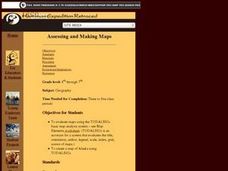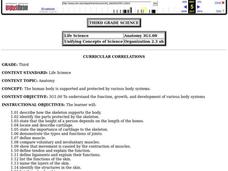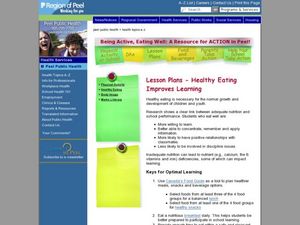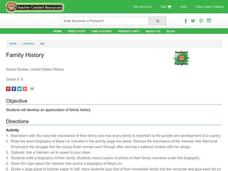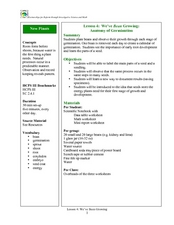Curated OER
Folk and Family Heroes and Heroines
Students define and assess the difference between folk heroes and family heroes and then find examples of each in their own lives. They view a "Swapping Stories" video, surf the internet for examples and complete a variety of worksheets...
Curated OER
My Favorite Breakfast Foods
First graders consider the importance eating breakfast. In this breakfast foods lesson, 1st graders plan meals, examine a variety of breakfast options, and discuss the food groups. Students taste a variety of foods. Extension activities...
Curated OER
Best Breakfast Authors
Third graders write a story. In this breakfast authors lesson, 3rd graders write about a breakfast food and why it is a good selection. Students may illustrate stories and share with their peers.
Curated OER
Food for Thought
Fifth graders explore the brain and what is needs. In this biology lesson plan, 5th graders will work on a series of activities that will allow them to learn about the brain, its parts, and the best foods to eat for their brain.
Curated OER
Making a Terrarium
Students become familiar with the materials needed to build a terrarium. In this terrarium lesson, students create a terrarium in a bottle and observe how it grows and takes care of itself.
Curated OER
How Has Transportation Changed Since the 1899 Harriman Alaska Expedition?
Students recognize modes of transportation. They research historical data from a variety of primary and secondary sources including the Harriman expedition journals, related web sites, and photographs from the expedition. Students...
Curated OER
What Do We Learn From the Repartiation of Alaska Native Artifacts?
Students observe and evaluate evidence of Alaska Native cultural symbols and artifacts. They research historical data from a variety of primary resources, including the Harriman expedition journals, related web sites, oral accounts,...
Curated OER
Learning About Location: Charting the Path of the George W. Elder
Young scholars acquire a working knowledge of the geographical concepts: absolute location, relative location, longitude and latitude. They analyze primary sources that shows the physical and human characteristics of the places along...
Curated OER
A Neighborhood Expedition
Students plan and conduct an expedition through their neighborhood based on the techniques used by the Harriman Expedition to Alaska in 1899. They research the Harriman expedition on the internet and then create a route and collection...
Curated OER
Assessing and Making Maps
Students evaluate maps using the TODALSIGs basic map analysis system, explained on the worksheet. They create a map of Alaska using TODALSIGs. Students brainstorm the elements of maps.
Curated OER
Skeletal System
Third graders describe and identify the parts of the skeleton and how they support the body. They observe two chicken bones that have been soaked in vinegar for 5 - 7 days. They observe the bone's appearance after it has been removed...
Curated OER
"Dreaming of Success" Unit
Students recognize the importance of planning for the future. They think about and project themselves into the future. Students become aware that everyone encounters challenges in life and that they can be met and obstacles can be...
Curated OER
Understanding My Pyramid
Students examine the food pyramid and construct a healthy meal. For this food pyramid lesson, students examine the new food pyramid that includes fats and oils, and is arranged with brightly colored triangles. They use grocery store adds...
Curated OER
A Walk to Remember by Nicholas Sparks
In this online interactive reading comprehension worksheet, students respond to 4 short answer and essay questions based on A Walk to Remember. Students may also access an online quiz on the selection using the link at the bottom of...
Curated OER
Healthy Eating Improves Learning
Students recognize that healthy food gives you better ability to concentrate and makes you more willing to learn. In this healthy food lesson, students choose food from Canada's food guide to create a healthy lunch and healthy snack.
Curated OER
Mixing It Up!
Third graders identify the different states of matter. In this science lesson, 3rd graders describe the different components of solutions and mixtures. They create emulsions, foams and suspensions in the lab.
Curated OER
Family History
Students appreciate how families are important to the expansion and progress of a country. In this biographies lesson plan, students read a biography and write their biographies including photos. Students create family trees.
Curated OER
We’ve Bean Growing: Anatomy of Germination
Students identify the main parts of a seed. In this biology lesson, students explain the factors needed for the seed to grow. They record observations everyday and report findings to class.
Curated OER
Parenting - Discipline and Guidance
Students learn the meaning/purpose of discipline and the various parenting types leading to obedience or self-discipline.
Curated OER
Getting Here from There
Students role-play early 20th century immigrants on their way to Indiana. They consider the methods of travel available to them and write a letter to a friend outlining their travel plans and adventures during the trip.
Curated OER
Solid Waste Recycling
Students seek scientific and technological solutions to envrionmental problems. They record class activities in a journal. They identify relationships among living things and their environments.
Curated OER
The Zabbaleen, Cairo's Garbage Workers
Here is a fascinating human geography study of the Zabbaleen. They are a sub-class of people who work as garbage collectors in Cairo, Egypt. I can't say enough good things about this resource in my limited space here. It is fabulous! If...
Earth Day Network
Staying Green While Being Clean
Clean up the environment with a lesson that focuses on replacing hazardous cleaning supplies with green, environmentally-friendly products. Using a dirty patch of surface as a control area, kids clean other parts of various surfaces...
Curated OER
Create a Graph Online
Scholars create colorful bar, line, or pie graphs. They decide on a survey question to ask or a type of data to gather. From there, they collect information and data. They display this data in bar, line, or pie graphs that they create...
Other popular searches
- Human Growth and Development
- Plant Growth and Development
- Child Growth and Development
- Human Growth & Development
- Fetal Growth and Development
- Animal Growth and Development
- Body Growth and Development
- Human Growth Development
- Child Growth Development
- Child Growth & Development









